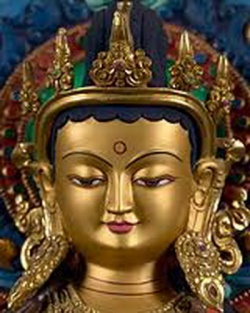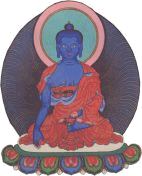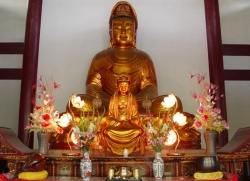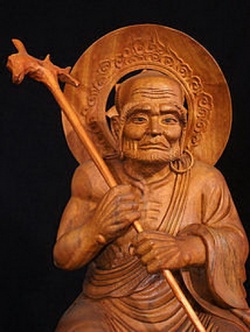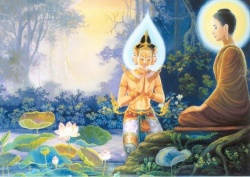Fa-hsiang
A school of Chinese Buddhism that teaches that all of reality is an Evolution of a fundamental level of Consciousness. Because of this, it is often refered to as the wei-shih, or ‘Consciousness-Only’ (Sanskrit, Vijñapti-mātra) school. This school derives from pre-existing streams of Indian Mahāyāna Thought based on the writings of Asaṇga and Vasubandhu which crystallized into the Indian Yogācāra (also known as the Vijñānavāda) school. This school taught that there are within each individual's Mind eight levels of Consciousness: the five senses, the Mind that gathers and processes their sensory data, a seventh Mind that is the centre of analytical Thought called manas, and finally, an eighth level called the ālaya-Vijñāna or ‘storehouse Consciousness’. This last contains all of the ‘seeds’ implanted by karmic acts which will in the future give rise to all perceptions and actions when conditions for them become right. In unenlightened beings, these seeds come to maturity as mistaken perceptions of reality, and give rise to its artificial division into ‘self’ and ‘other’, obscuring the realization that all things are equally projections of the ālaya-Vijñāna. Enlightenment (Bodhi) comes about when beings realize that all things are merely evolutions of the ālaya-Vijñāna, that is, are ‘Consciousness-Only’, thus eradicating any remaining notion of a separation of self and other, or that Phenomena enjoy any kind of independent existence.
Fa-hsiang, school of Chinese Buddhism derived from the Indian Yogācāra school.
Another feature of Fa-hsiang Thought was the analysis of the World into three levels of Perception and existence, called the ‘three natures’ (san hsing). The first, representing objects of Perception, was called the ‘other-powered nature’ (Sanskrit, paratantra-Svabhāva; Chin., ta ch'i hsing) since they arose only in dependence upon causes and conditions external to themselves. The second was the ‘imaginary nature’ (Sanskrit, parikalpita-Svabhāva; Chin., suo chih hsing), and represented things as mistakenly perceived by the unenlightened, that is, as independently existing things that are separate and distinct from the Consciousness that perceives them. The third was called the ‘consummate nature’ (Sanskrit, pariniṣpanna-Svabhāva; Chin., ch'eng shih hsing), and represented things perceived correctly by an Enlightened Consciousness, that is, as evolutions of that Consciousness with no distinction between subject and object. An aspect of this school's teaching that was to have decisive consequence for its fortunes in China was the idea that there were certain beings, called icchantikas, who lacked any seeds of Buddhahood in their makeup, and thus would never attain this goal.
The school in China traces its origin to the Indian Monk-translator Paramārtha (499-569), who arrived in China in 546. Among the many texts that he brought and translated, he was best known for his teaching of Asaṇga's Mahāyāna-saṃgraha (Compendium of the Mahāyāna). Known in China by its short title She-lun, it became the basis for the She-lun school that studied it intensively. Later, the great Chinese pilgrim and translator Hsüan-tsang (596-664) brought back and translated many more Indian Yogācāra texts, and a new school consolidated around him, superseding the older She-lun school. However, the teaching of icchantikas did not suit the atmosphere of Chinese Buddhism, which took universal salvation as an object of Faith, and so the school did not survive past the first generation of Hsüan-tsang's disciples, the best-known of whom was K'uei-chi (632-82). The system of doctrinal classification put forward by the Hua-yen school shortly thereafter placed Fa-hsiang at the level of ‘elementary Mahāyāna’, just one step above Hīnayāna.
Interestingly, when Buddhism experienced a revival of Interest among Intellectual circles in the late 19th and early 20th centuries, Fa-hsiang studies came to the forefront once again. The revivers saw in Fa-hsiang Thought the best chance for harmonizing traditional Buddhist Philosophy with the modern scientific viewpoint. See also Hossō; wei-shih.
The Fa-hsiang school is the Chinese continuation of the Indian Yogacara (or Vijnanavada). Fa-hsiang literally means "Characteristic of Dharma". It refers to the central notion of the school, which states that everything is only ideation. This means that the external world is only the product of our consciousness and possesses no reality, they are of the nature of pure Consciousness (vijnana), "consciousness-only" (vijnanamatrata, vijnaptimatrata), or "Mind-only" (Chittamatra). The school thus is referred to as the school of "Mind-only".
The Indian Yogachara was founded by two brothers, Asanga and Vasubandu, native of North-West India, in the 4th or 5th century. The Asanga and Vasubandu were encyclopaedic systematisers, who developed ideas already established in older writings, such as the Abhidharma, the Prajnaparamita, and the Lankavatara, and gave definitive form to earlier Mahayanist concepts and the theory that reality is consciousness-only.
The Chinese Yogachara school was founded by Hsuan-tsang (600-664, Fig. 2), a Chinese pilgrim-translator, and his student ppKwei-Ji[[(638-682), who systematized the teaching. Hsuan-tsang went to India and studied the doctrines derived from Dharmapala (?-507) and taught at the Vijnanavada center in Valabhi. When he returned to China (Great-Goose-Temple, Chan-Yan), he translated Dharmapala's Vijnapti-matratasiddhi and and many other works. His teachings mainly followed the line of Dharmapala.
The most important book of the school is the Vijnaptimatrata-siddhi (Chin., Cheng-wei-shih-lun, proof of Nothing-but-Cognition) by Hsuan-tsang, a compendious work in which the teaching of the school is presented in detail. The Sandhinirmochana and Lankavatara sutras are also influential in the formulation of the doctrines of Fa-hsiang.
The special characteristics of this school are its emphasis on meditation and a broadly psychological analysis. Fa-hsiang developed a teaching on eight types of consciousness in order to explain the process of ideation (alaya-vijnana). The common view that external things exist is due to an error or misconception that is removable through a meditative process that brings a complete withdrawal or “revulsion” from these fictitious externals and an inner concentration and tranquillity through Yoga practice.
Fa-hsiang reduces all of existence to 100 (=8+51+11+24+6) dharmas, which are further divided into five categories:
(1). Primary consciousness (vijnana): 8 mental dharmas (cittadharma), comprising
visual consciousness (eye)
auditory consciousness (ear)
olfactory consciousness (nose)
gustatory consciousness (tongue)
tactile consciousness (body)
mano-vijnana, the thinking consciousness that coordinates the perceptions of the sense organs (cognition)
manas-vijnana, the self-conscious defiled mind, which thinks, wills, and is the principal factor in the generation of subjectivity (cognitive faculty)
alaya-vijnana, the storehouse consciousness
(2). Attendant mental factors (chetasika): 51 mental functions or capacities, dispositions, and activities (caitasika-dharma).
(3). Form (rupa): 11 elements concerned with material forms or appearances (rupa-dharma).
(4). Dharmas independent of mind: 24 things, situations, and processes not associated with the mind--e.g., time, becoming (cittaviprayuktasmskara)
(5). Unconditioned (asamskrita) dharmas: 6 non-created or nonconditioned elements (asamskrta-dharma)--e.g., emptiness or "true suchness"(tathata).
The storehouse consciousness is postulated as a receptacle of the imprint of thoughts and deeds, the vasana (literally “perfuming”) of various karmic seeds (bijas). The seeds develop into touch, mental activity, feeling, perception, and will, corresponding to the five skandhas. Then ideation (manas) develops.
The process of purifying the subject-object duality and notions of false existence and restored to the pure state of the storehouse consciousness is the only means, according to this school, to achieve the Buddhahood or the undifferentiated state. To address the process in detail, three modes (svabhava) are introduced:
Parikalpita-svabhava (Chinese, Pen-Ji-Shuo-Shi-Shin): the mere fictions of false imagination. Which believes all dharmas are real.
Paratantra-svabhava (Chinese, I-Ta-Chie-Shin): the related existence of things, under certain conditions or aspects. It is called dependent rising, means all things are collections of parts with certain condition and all the parts are not real, therefore the thing itself is not true either.
Parinispanna-svabhava (Chinese, Wuene-Chin-She-Shin): the perfect mode being corresponding to right knowledge. It is the “true suchness” itself.
Fully understand the above threefold version of the modes is the correct path to transform consciousness to wisdom. Four types of wisdom can be obtained if the eight primary consciousness(es) (vijnana) can be practiced properly, they are:
The wisdom of accomplishing activities: wisdom of purifying normal external activities, purposes and so forth. It can be achieved by proper transformation of the first five consciousness(es) to this wisdom.
The wisdom of individual analysis: wisdom of analyzing different objects or identifying the different characters from the same object. It can be achieved by proper transformation of the mano-vijnana to this wisdom
The wisdom of equality: wisdom of treating experiences such as having been pleasurable, painful and neutral equally. It can be achieved by proper transformation of the manas-vijnana to this wisdom.
The grand-round-mirror-like wisdom: like mirror can reflect many objects simultaneously, the wisdom can perceive many objects accurately and simultaneously. It can be achieved by proper transformation of the alaya-vijnana to this wisdom. It is the state of the Buddhahood.
These four wisdoms lead the practitioners to four Nirvana:
Nirvana with residue: realizes the nature of Nirvana but not yet eliminate the five aggregates (form, feeling, discernment, compositional factors and consciousness).
Nirvana without residue: the aggregates have been eliminated.
Svabhava Nirvana: realizes the Primeval Nirvana is always existing.
Nonabiding Nirvana: abides in neither Samsara nor ulitmate quiescence. The Nirvana of the highest Bodhisattvas.
The forth Nirvana transform the normal body of practitioner into three ultimate Buddha bodies. They are:
Dharma-kaya: the true body.
Sambhoga-kaya: the enjoyment body.
Nirmana-kaya: emanation body.
